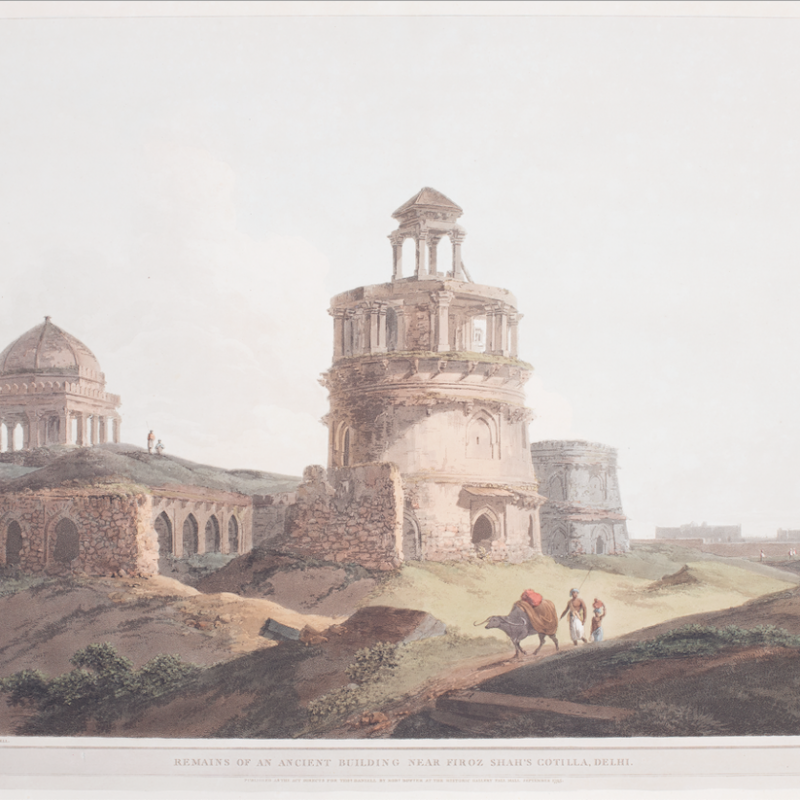Thomas Daniell (1749–1840) and his nephew William Daniell (1769–1837) travelled extensively in India between 1786 and 1793. On their return to Britain they produced many paintings, drawings and prints based on the sketches they had made while travelling. The 144 aquatint prints, collectively known as 'Oriental Scenery', represent the single largest and most impressive project by English artists to depict Indian architecture and landscape. (Photo Source: DAG)
Related Event: The entire Oriental Scenery collection (144 prints) is on display at the Drishyakala museum, by DAG in collaboration with ASI (Barrack Number 4, Red Fort, Delhi) till January 2020.
Thomas Daniell and his nephew William were among the earliest professional British landscape painters to visit India in the late-18th century. Despite the many later artists who followed, including some of the calibre of Edward Lear and William Simpson, their body of work has never been surpassed in terms of its range and quality. The 144 aquatint prints collectively known as Oriental Scenery represent the single largest and most impressive project by English artists to depict Indian architecture and landscape. Over the seven years that they were in India, the duo produced many paintings, drawings and prints based on the hundreds of sketches they had made while travelling. They continued to work on Indian subjects after their return to Britain.
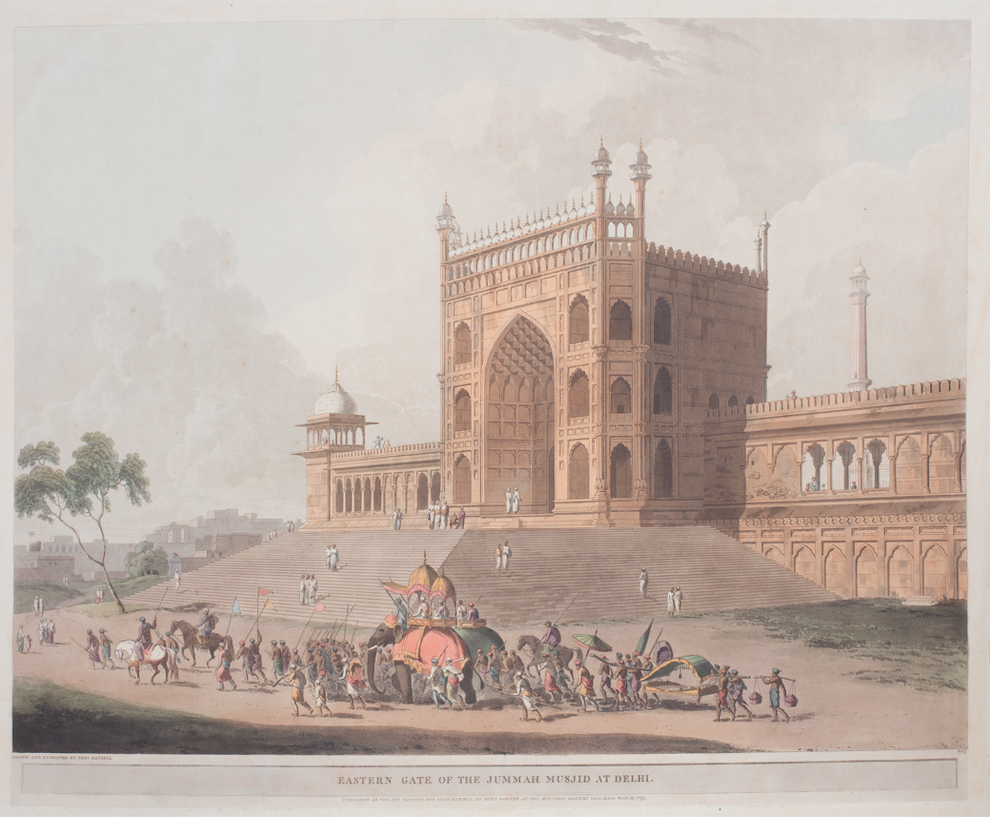
Eastern Gate of the Jummah Musjid at Delhi, drawn and engraved by Thomas Daniell, March 1795 (Photo Source: DAG)
Their travels took them across the length and breadth of undivided India, starting in Calcutta in the east following the Ganges to the north-west, and then towards Madras, in the south. For current viewers of their paintings, the dramatic change in landscape from then to now is breathtaking. While art historians do sometimes point out European influences in the flora, there is no denying that this collection of over 100 paintings is easily one of the best artistic documentation of undivided India.
However, Thomas Daniell’s voyage to India was in many ways unlikely. The son of an innkeeper, he began his working life as a bricklayer and then as an apprentice to a coach builder. At the age of 21 he became assistant to Charles Catton, who was the coach painter for the King. This inspired his ambition to become an artist and after a couple of years he got a chance to study at the Royal Academy Schools. At the Academy’s regular annual exhibitions, he exhibited a variety of paintings, including flower pieces and literary subjects. He first turned to architecture and landscape in 1781 when he was commissioned to produce six views of a wealthy patron’s country house. Judging from his subsequent submissions to Academy shows, that opening seems to have directed his attention towards dramatic landscape.
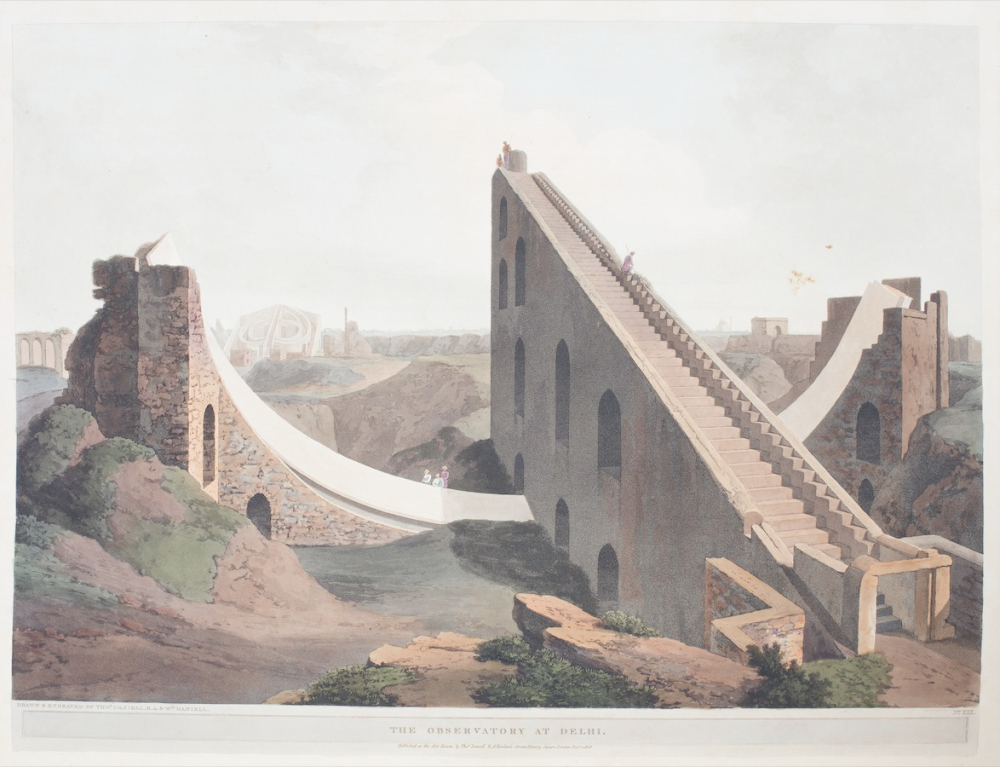
Tremal Naig's Choultry, Madura, drawn by Thomas Daniell; engraved by Thomas and William Daniell, November 1798 (Photo Source: DAG)
The idea of going to India was in some ways a smart one. There were stories of artists like Tilly Kettle and George Willison who had made great fortunes there. John Zoffany and Thomas Hickey were both still there then and doing well. But all these artists were portrait painters; there was less evidence to suggest that a landscape painter could thrive as well. True, William Hodges had worked in India as a landscape painter between 1780 and 1783 and secured the patronage of the Governor General, Warren Hastings. But that example, though encouraging, was exceptional. Why would English patrons in India be any different in their prejudices from those at home? Furthermore, the only way to get there, in the days before commercial travel, unless you were going to walk all the way overland, was to travel in an East India Company vessel. You had to apply to the Company for permission to travel, and the Board of Directors were chary of being lumbered with people who might not prosper in India and might require shipping home.
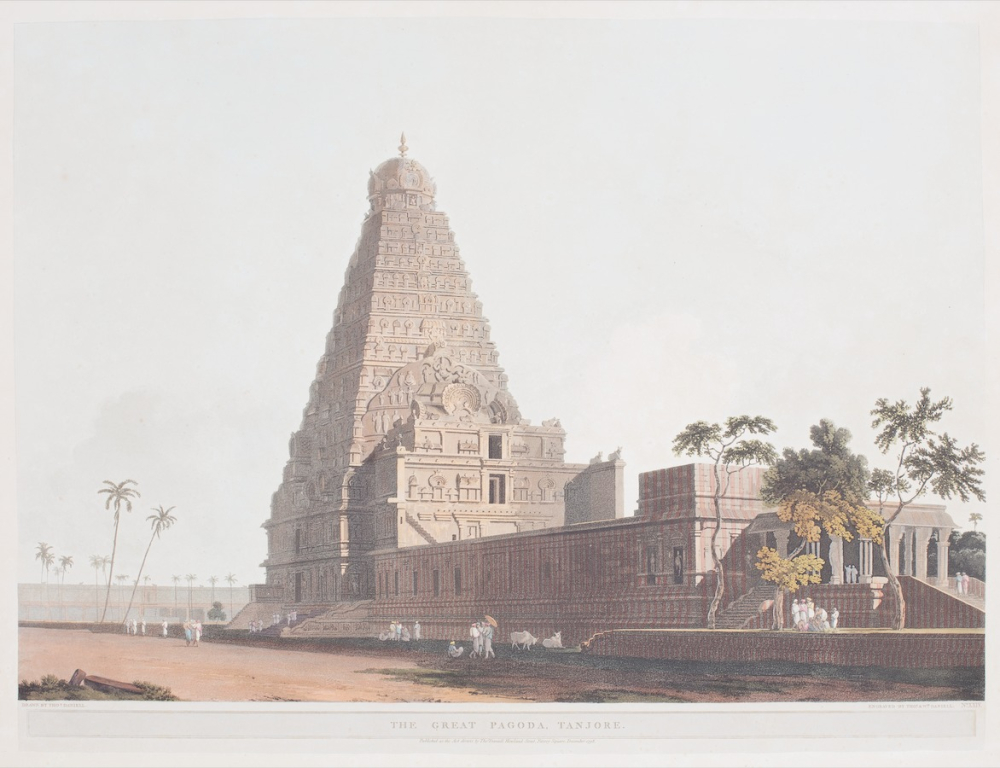
The Great Pagoda, Tanjore, drawn by Thomas Daniell; engraved by Thomas and William Daniell, December 1798 (Photo Source: DAG)
So when submitting his application in 1784, Daniell described himself as an engraver, as if to imply that he wasn’t just another artist but someone with a professional skill that was in short supply in India. That was canny but not wholly truthful. By this time he had begun to experiment with printing, but was far from mastering it. And his nephew William, described as his ‘assistant’, was then aged just 15. But it worked. Permission was granted by the end of the year and in April of 1785, they embarked.
Their route, to a modern view, was as unlikely as everything else about the venture. The Company’s trade at this time focused on the South China Coast, and the Atlas, the ship in which they sailed, was headed for Canton. So they sailed right past India, reaching Whampoa (China) in August, from where they caught another ship that took them back to Calcutta, where they arrived early in 1786.
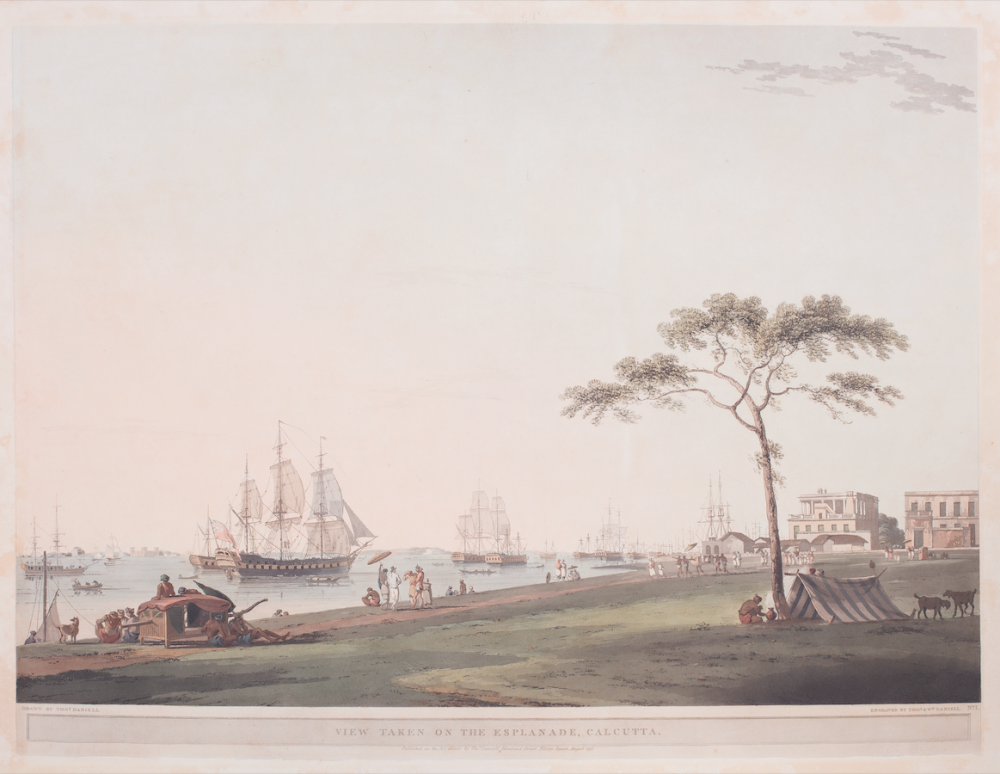
View taken on the Esplanade, Calcutta, drawn by Thomas Daniell; engraved by Thomas and William Daniell, August 1797 (Photo Source: DAG)
Thomas Daniell was aware, as he and his nephew toured India, selecting and sketching views, that their compatriots were busily engaged in conquering it. Obviously, the British conquest of India gave Daniell both the motive and the opportunity to come here. But Daniell was inclined to think that art was immune from the messy matters of conquest and commerce, and that it existed on a higher intellectual plane. Writing in 1810, he expressed this idea rather eloquently:
‘It was an honourable feature in the late [i.e. 18th] century, that the passion for discovery, originally kindled by the thirst for gold, was exalted to higher and nobler aims than commercial speculations. Since this new era of civilisation, a liberal spirit of curiosity has prompted undertakings to which avarice lent no incentive, and fortune annexed no reward: associations have been formed, not for piracy, but humanity: science has had her adventurers, and philanthropy her achievements: the shores of Asia have been invaded by a race of students with no rapacity but for lettered relics … It remains for the artist to claim his part in these guiltless spoliations, and to transport to Europe the picturesque beauties of those favoured regions.’[i]
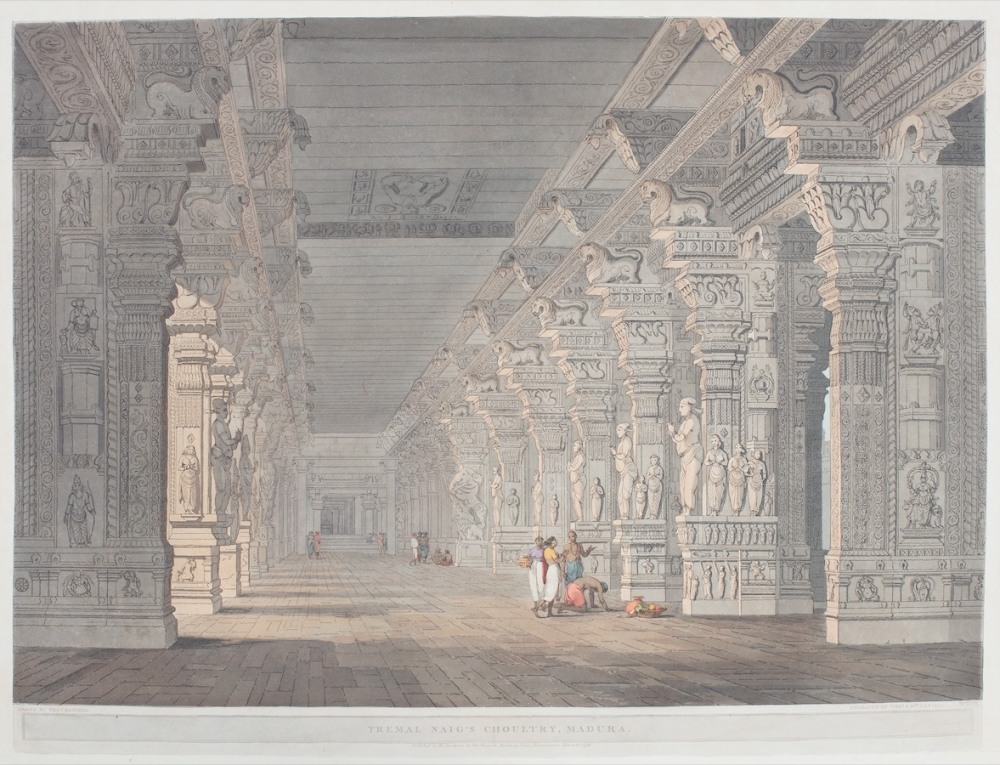
Tremal Naig’s Choultry, Madura, drawn by Thomas Daniell; engraved by Thomas and William Daniell, November 1798 (Photo Source: DAG)
Early writers on the Daniells accepted his comments uncritically and saw his work as unproblematic. But over the last 40 years, scholars have been more inclined to question the nexus between art and imperialism, in a wide range of contexts. It would now be routine to take as a starting point the idea that colonial art—like any other colonial product—both reflects and reinforces colonial ideology. Across different regions and time periods it varies immensely in type and style and in its methods of communicating.
Abridged from Giles Tillotson’s forthcoming edited volume on the Daniells’ Oriental Scenery to be published by DAG. The entire Oriental Scenery collection (144 prints) is on display at the Drishyakala museum, by DAG in collaboration with ASI (Barrack Number 4, Red Fort, Delhi) till January 2020.
Notes
[i] Thomas Daniell, Introduction to A Picturesque Voyage to India by the Way of China by Thomas Daniell and William Daniell (London: Longman, Hurst, Rees, and Orme, 1810)
